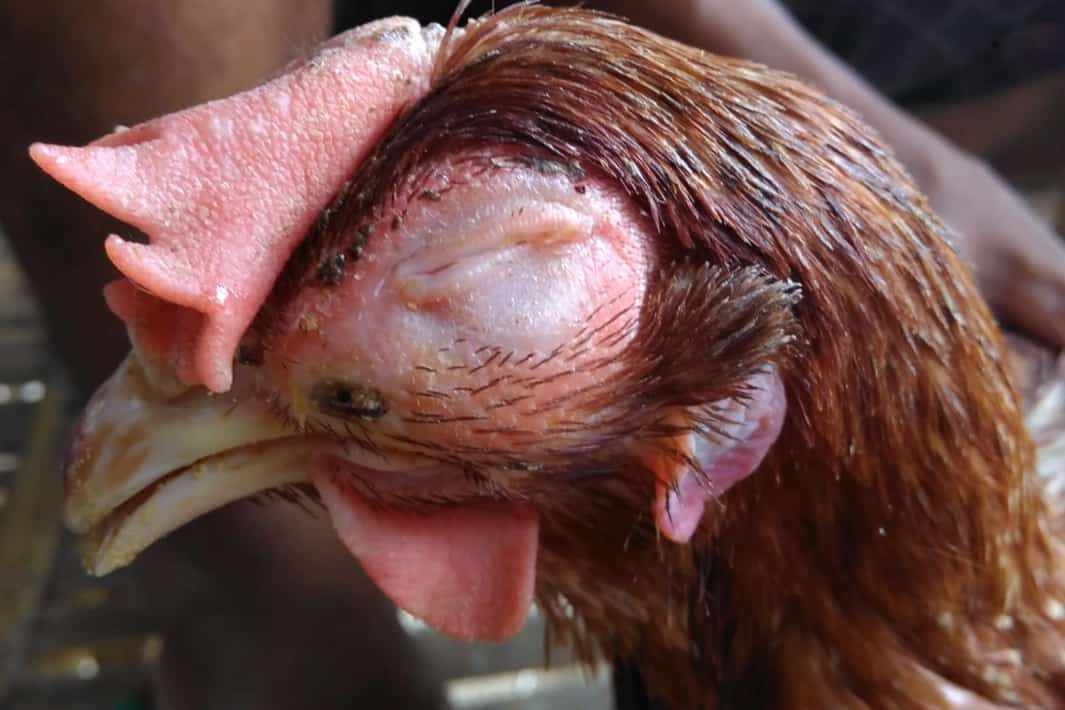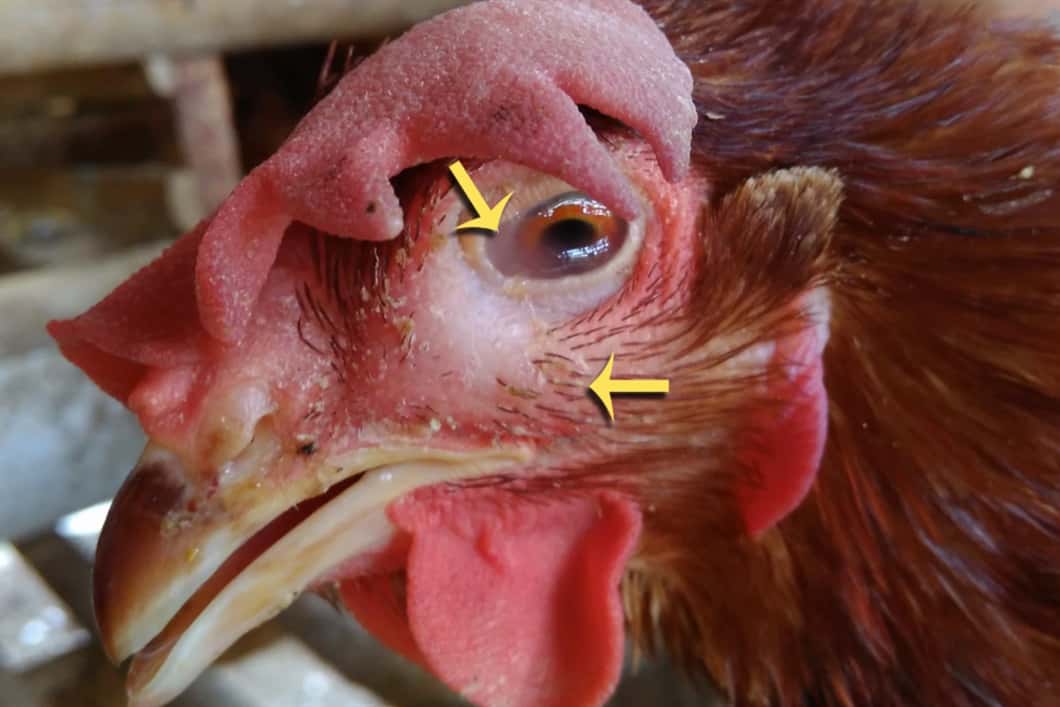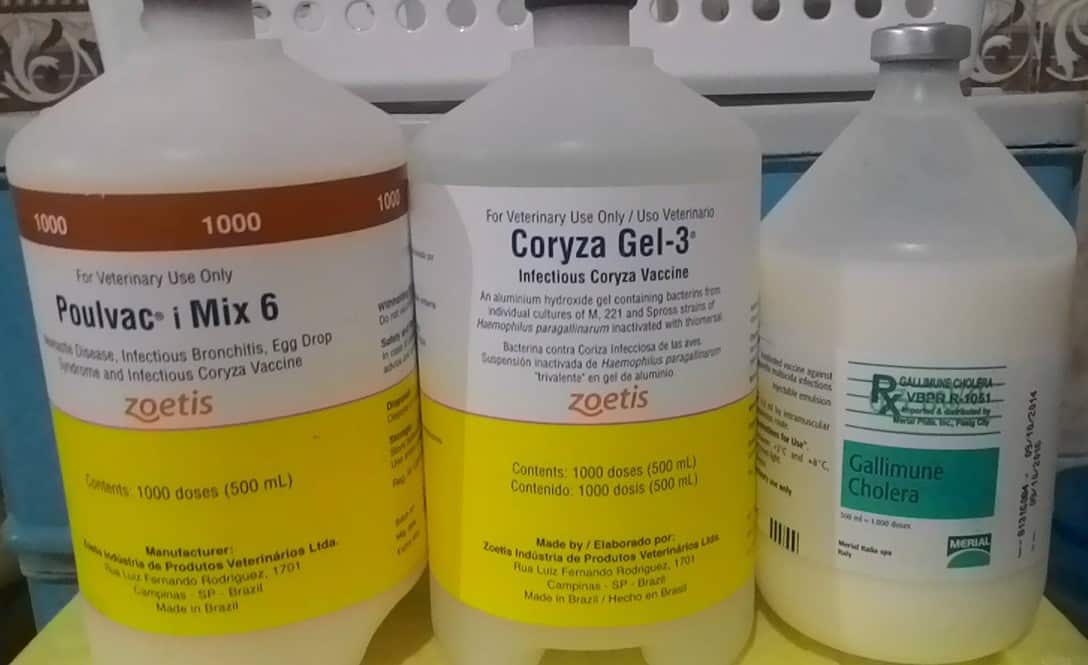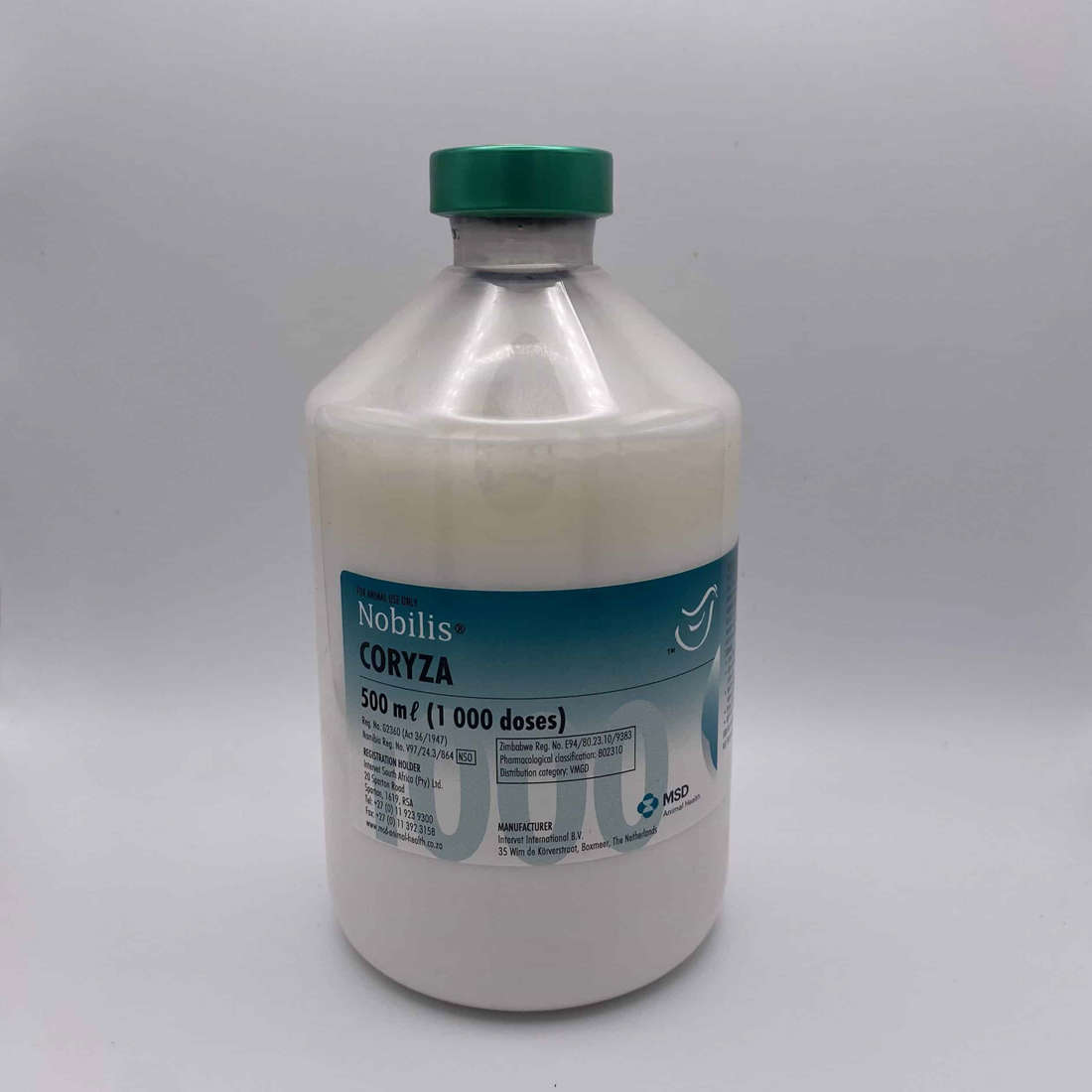Contagious Infectious Coryza in chickens is a bacterial respiratory infection. This infectious disease strikes most often in adult chickens. Infectious Coryza in bird symptoms involves inflammation around the face and wattles. There are also pus-like excrete from the nostrils and eyes, breathing difficulties, loss of appetite, sneezing, and decreased weight and egg production.
This article will cover:
- What Is Infectious Coryza In Chickens?
- How Chickens Acquire Infectious Coryza?
- Infectious Coryza Clinical Signs and Symptoms
- Infectious Coryza in Fowls Treatment
- Infectious Coryza Prevention and Sanitation
What Is Infectious Coryza In Chickens?

Let’s discuss more on what is Infectious Coryza (IC) in chickens. Other names of this disease are Cold, Catarrh, Infectious Catarrh, Roup, and Hemophilus Infection. Coryza, in layman’s terms, is head cold or common cold.
IC is a severe upper respiratory disease of chickens set off by Avicabacterium paragallinarum. Earlier names of these bacteria are Haemophilus paragallinarum and Haemophilus gallinarum. Though it’s most predominant in the Southern States and California in the USA, IC strikes worldwide.
IC as a common cold is more severe in chickens than our common cold. More breeders and vets describe it as extreme cold but worse in both short and long period effects.
The Infectious Coryza in poultry gets to it hastily, with all chickens at risk indicating symptoms of the disease within 24-72 hours after their contact with the infection. The usual signs are facial swelling, especially in the nostril areas with a clear watery discharge with an offensive smell and pus-filled later on.
The birds may also show signs of inflamed wattles. They will have noticeable conjunctivitis. The chickens’ tearing or watery eyes, called lacrimation, will eventually be partly or entirely closed because of the extreme eye discharge. The eye infection will make the chickens have difficulty eating and drinking.

In uncomplicated cases, the IC progression is approximately 7-11 days. When coexisting infections complicate the disease, the progress can continue for a month or longer. This disease may not be as dangerous to your poultry as lymphoid leucosis or Marek’s. Still, it can have the same fatal result to older and weaker chickens.
The chickens acquire Infectious Coryza (IC) through contact with another infected bird. What’s more, once a bird catches this bacteria, it’s a carrier for long periods even when recovered. When a flock gets infected, then all chickens are deliberated as carriers. It’s crucial to note that fowls can be more prone to this bacteria when already affected by other bacterial or respiratory viral diseases.
How Chickens Acquire Infectious Coryza?
Infectious Coryza can affect chickens at any age, but older chickens are typically more susceptible. What’s more terrible is that it occurs mainly in the period of the poultry’s egg-laying peak season. It appears in laying hens when transferred, for example, from a pullet pen to a laying-hen pen.
Unfortunately, your chickens can become bacteria carriers while being asymptomatic. That means these chickens don’t have any noticeable symptoms of the bacteria.
That’s the reason why a lot of breeders that don’t practice an “all in, all-out” policy find it very challenging to control the IC. Also, IC spreads through consumed feed or water, aerosols, even people, and contaminated garments and equipment.
Transmissions commonly occur when a new chicken comes to the flock that is already a carrier. Most backyard breeders will observe that their whole flock has it within approximately ten days of the first contact.

Keeping all their food and water containers clean is crucial even when it’s the least possible source of bacteria. Transmission by contaminated food and water only occurs when a sick chicken has a secretion that falls inside the water or food supply. Though it is less likely, it will happen, it can also cause the other chickens to acquire the bacteria.
However, it is important to note that not all birds that have recovered from the bacteria will continue to be carriers of the organism. Sometimes, these carriers may flake the bacteria at some stage in their lives, especially when stressed.
Your chickens may be at risk of this bacteria when they are out in the open at bird swaps, poultry shows, and live-bird sales. An outbreak usually happens when you bring an infected chicken that didn’t show any disease symptoms to a healthy flock.
Vulnerable chickens exposed to infected ones will show symptoms of the bacteria within 1-3 days. By that time, these susceptible chickens are already carrying the bacteria to the entire flock.
Infectious Coryza Clinical Signs and Symptoms

Infectious Coryza results in blood and circulatory system diseases, digestive diseases, and respiratory diseases in poultry. There are different symptoms of Infectious Coryza that can be confused for something else. But when you observe all these clinical signs altogether, there’s no misidentification of the diagnosis.
- Facial Swelling – It’s one of the most noticeable clinical signs in chickens with Infectious Coryza. The swelling appears under the eyes, cheeks, and wattles.
- Nasal and Ocular Discharge – Due to swollen infraorbital sinus, there will be a nasal and ocular discharge, another blatant symptom of IC in birds. Chickens will sneeze and cough frequently. That would be one of the reasons to spread the organism in poultry.
- Changes in Comb – Comb becomes pale and sometimes swollen as well.
- Conjunctivitis – It’s one of the prominent symptoms is bubbles appearing at the corner of the eyes.
- Breathing Difficulties – Breathing is labored, and you can hear some wheezing. Chickens also open their mouth when breathing.
- Lower Respiratory Tract Affected – You would know when there’s an infection in the lower respiratory tract because breathing sounds like rales or wrinkled paper.
- Change in Appetite – There’s a drop in appetite and even in drinking.
- Lethargy – Your chickens will have difficulty in walking and become very weak.
- Egg Production – Hens affected by IC will also have a drop in egg production from 10 to 40%. More so, the eggshell will also become fragile.
- Diarrhea – Other chickens with IC will also experience diarrhea.
- Eyelids – Chickens’ eyelids with IC can become stuck together and crusty.
- Strong Odor – The organism gives off a foul smell like rotten eggs.
Death loss is low, around 20 percent unless the illness causes difficulties with other agents like E. coli or Mycoplasma gallisepticum. The disease can remain for a few days to a few months, especially when secondary contaminations happen.
Infectious Coryza in Fowls Treatment

Give the Right Antibiotics
Wrong antibiotics administered to your poultry may not only be inefficient. Still, it can also put your chickens at risk in the long run, plus develop some antibiotic resistance. The best remedy is prescribed medicine from a veterinarian who runs tests to identify the organisms causing the disease.
The standard antibiotics used are streptomycin, erythromycin, dihydrostreptomycin, tylosin, sulphonamides, and fluoroquinolones which inhibit carriers. But this varies to the availability of the vet’s choice as well. The fact is these antibiotics will treat the severe infection, but the birds affected by the disease will be carriers for the rest of their lives.
Isolate Infected Chickens
And the chicken carrier of Infectious Coryza will flake the bacteria at any time. So, any new birds added to the poultry can be infected. The carriers can also have setbacks at any time and will need antibiotic remedies again.
Another less costly solution is to depopulate the sick flock and a final cleaning and disinfecting procedure. After that, you can restock with new chickens free of IC.
One remedy breeders do when they cannot go to a vet immediately is to separate the sick chickens. Isolate these fowls in a warm place.
Supplement Their Treatment
Feed these sick chickens with Infectious Coryza with food and water. One tablespoon apple cider vinegar to 1 gallon of water plus crushed garlic can somehow relieve your chickens, but this tonic won’t treat them.
Other natural remedies are grapeseed extract and colloidal silver. These natural therapies gain a lot of positive feedback.
The best approach is to always consult with your vet before administering any tonics or medications to your poultry. Infectious Coryza treatment needs antibiotics, and only your veterinarian will be able to prescribe them.
Infectious Coryza Prevention and Sanitation
All-in/ All-out Policy
In an all-in/all-out production policy, aim to gather only chickens that are free of Infectious Coryza. More so, hygiene procedures are the ideal method to prevent IC. Commercial vaccines or bacterins are also on hand to help manage fowl cholera within the poultry.
But commercial bacterins may not entirely save you from harming your chickens against all field strains. Still, at least it can care for against homologous strains. Vaccination is not also a good option except when fowl cholera develops in the coop. Sanitation is the best practice to prevent IC.
Proper Sanitation
You can kill the IC organisms by heat, drying, and disinfecting. That’s why proper sanitation practice is a must. That means cleaning coops at least twice a year or more is a good practice. And if your chickens’ coop is cold and damp, you might need to renovate it to keep your fowls warm and dry.
The bacteria can hook back to your flock with no difficulty when you wear the same clothing and boots. So, to lessen the likelihood of transmitting a disease to your poultry, don’t wear the same clothes and boots when visiting your poultry.
Proper sanitation of your chickens’ houses includes:
- Entirely depopulate every year with certain breaks among older birds and their alternates.
- Correct resolution of mortality
- Warrant a successful rodent control system.
- After flock dispersal, sanitize and disinfect all equipment and houses.
- Empty for at least three months all contaminated yards and areas.
- Keep your chickens far and away from wild animals and birds.
Quarantine New Chickens

Furthermore, quarantine for at least a month if you have a new bird to introduce into your flock. It’s because no matter how healthy the chicken may look, it can be an IC carrier.
If you bring your chicken to bird shows, make sure they have separate pens or quarters. Poultry shows are breeding grounds for different contagious illnesses, including IC.
The best action to do when you suspect your flock has IC is to consult a vet sooner. There’s nothing more beneficial than a quick visit to a medical expert.
Infectious Coryza Vaccine

Vaccines are an important factor in protecting chickens from infectious coryza. Vaccination will produce protective immunity within the chicken, making it more difficult for the bird to become ill if exposed to one of its causative agents.
Vaccination works by introducing a weakened form of the disease-causing organism into the body of a healthy bird. This enables the bird’s immune system to recognize, remember, and prepare to fight off future exposure to the disease. Vaccinated birds may also provide some degree of passive protection to other unvaccinated birds they come into contact with due to their enhanced immune response.
Here are some common vaccines against infectious coryza:
Nobylis Coryza

Poulvac Coryza is a vaccine produced by MSD Animal Health for the prevention of avian coryza. Nobilis Coryza provides an economical solution to manufacturers that require rapid onset of immunity against these diseases. It effectively reduces signs related to these infectious agents such as sneezing, coughing, poor feed intake, and droopiness in chickens.
Poulvac Coryza

Poulvac Coryza is a consumer poultry vaccine containing an inactivated whole-virus strain of avian coryza produced by Zoetis Inc. The solution can be administered via drinking water, or thru injection to chickens as early as 8 weeks.
The vaccine contains three strains of live avirulent ILT virus and one strain of inactivated Coryza antigen for effective protection against a wide range of subtypes and field isolates found globally. It helps reduce clinical signs, decrease mortality, and minimize shedding to help improve the health status of your flock.
Final Thoughts
Infectious Coryza in chicken is chronic even when it’s a low-mortality disease. It’s a weakening disease, especially for older chickens. And you may have to require antibiotics, increased care, and isolation throughout the chickens’ lifetime.
Proper sanitation programs and following proper guidelines can assist you in providing the best health for your poultry, free from chronic and infectious diseases such as Coryza.


Joseph Hudson has been raising chickens for over 15 years. In 2018, he completed the Agriculture & Natural Resources program at Mt. San Antonio College. He currently raises over 1400 chickens on his 7.5-hectare farm. He keeps sharing his experience on raising healthy and happy chickens on Chicken Scratch The Foundry.








Thank you
What is bast madicin coryza my 10 bard infarcted
I really learned a lot from the article it has improved my knowledge on IC disease tanx.
Please I need help all my local chicks are all infected.. what can I do
Exactly what happened in my broiler farm, when I lost half of birds to coryza due to ignorance
Can the eggs be carriers ? I hatched out some eggs and had a chick born with w small hard piece of theirs puss in one eye all the other 30 chicks are on with no issue
thanks i have learnt alot